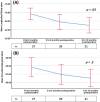Myocardial deformation in children post cardiac surgery, a cross-sectional prospective study
- PMID: 39556306
- PMCID: PMC11573953
- DOI: 10.1186/s43044-024-00578-z
Myocardial deformation in children post cardiac surgery, a cross-sectional prospective study
Abstract
Background: Myocardial deformation by speckle tracking echocardiography provides valuable information on the left ventricular function. The study aims to assess myocardial deformation in terms of left ventricular strain as an indicator of myocardial function in children after cardiac surgery at outpatient follow-up visits.
Methods: The study design was a prospective observational cross-sectional study that included pediatric patients after biventricular cardiac surgery during the postoperative follow-up visits in the outpatient department. In addition to conventional echocardiographic examination, two-dimensional speckle tracking echocardiography was done to evaluate myocardial deformation in terms of left ventricular strain. Echocardiographic measurements were done offline and were compared to published reference normal values for age. Study subjects were divided according to age at follow-up into four groups (1 month-1 year, 1-2 years, 2-5 years, and 5-11 years).
Results: Over ten months, 100 patients (64 males and 36 females) were included in the study. The median age was 30.8 months (IQR 12.8-65.3 months), the median weight was 11.7 kg (IQR 8-17 kg) and the median duration after surgery was 7.3 months (IQR 3.2-30.8 months). Longitudinal strain values were significantly (p < 0.001) lower than reference values for different age groups. Global circumferential strain showed no significant difference from the reference values. The duration after surgery had a statistically significant effect on longitudinal strain values, with improvement of the strain values with increasing intervals after surgery.
Conclusion: Using myocardial deformation method to evaluate cardiac function may detect underlying cardiac function abnormalities even with normal traditional functional parameters, which could have implications for patient management and follow-up.
Keywords: Cardiac function; Cardiac surgery; Congenital heart disease; Myocardial strain.
© 2024. The Author(s).
Conflict of interest statement
Figures


Similar articles
-
Fetal Cardiac Function in Maternal Diabetes: A Conventional and Speckle-Tracking Echocardiographic Study.J Am Soc Echocardiogr. 2018 Mar;31(3):333-341. doi: 10.1016/j.echo.2017.11.007. Epub 2017 Dec 13. J Am Soc Echocardiogr. 2018. PMID: 29246511
-
Reference values for two-dimensional myocardial strain echocardiography of the left ventricle in healthy children.Cardiol Young. 2019 Mar;29(3):325-337. doi: 10.1017/S1047951118002378. Epub 2019 Feb 19. Cardiol Young. 2019. PMID: 30777588
-
Longitudinal Changes in Ventricular Mechanics in Adolescents After the Fontan Operation.J Am Soc Echocardiogr. 2023 Sep;36(9):998-1007. doi: 10.1016/j.echo.2023.04.021. Epub 2023 May 25. J Am Soc Echocardiogr. 2023. PMID: 37236378
-
Perioperative assessment of myocardial deformation.Anesth Analg. 2014 Mar;118(3):525-44. doi: 10.1213/ANE.0000000000000088. Anesth Analg. 2014. PMID: 24557101 Free PMC article. Review.
-
European Association of Cardiovascular Imaging/Cardiovascular Imaging Department of the Brazilian Society of Cardiology recommendations for the use of cardiac imaging to assess and follow patients after heart transplantation.Eur Heart J Cardiovasc Imaging. 2015 Sep;16(9):919-48. doi: 10.1093/ehjci/jev139. Epub 2015 Jul 2. Eur Heart J Cardiovasc Imaging. 2015. PMID: 26139361 Review.
References
-
- Geyer H, Caracciolo G, Abe H, Wilansky S, Carerj S, Gentile F et al (2010) Assessment of myocardial mechanics using speckle tracking echocardiography: fundamentals and clinical applications. J Am Soc Echocardiogr 23:351–369. 10.1016/J.ECHO.2010.02.015 - PubMed
-
- Levy P, Sanchez MA, Machefsky A, Fowler S, Holland M, Singh G (2016) Reference ranges of left ventricular strain measures by two-dimensional speckle-tracking echocardiography in children: a systematic review and meta-analysis. J Am Soc Echocardiogr 29:209–225. 10.1016/j.echo.2015.11.016.Reference - PMC - PubMed
-
- Buckberg G, Hoffman JIE, Mahajan A, Saleh S, Coghlan C (2008) Cardiac mechanics revisited: the relationship of cardiac architecture to ventricular function. Circulation 118(24):2571–2587. 10.1161/CIRCULATIONAHA.107.754424 - PubMed
-
- Bussadori C, Moreo A, Di Donato M, De Chiara B, Negura D, Dall’Aglio E, Lobiati E, Chessa M, Arcidiacono C, Dua JS, Mauri F, Carminati M (2009) A new 2D-based method for myocardial velocity strain and strain rate quantification in a normal adult and paediatric population: assessment of reference values. Cardiovasc Ultrasound. 10.1186/1476-7120-7-8 - PMC - PubMed
LinkOut - more resources
Full Text Sources
